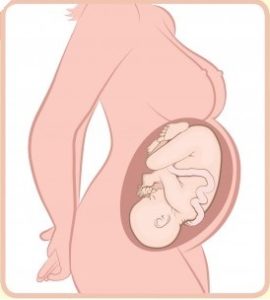Usually, by 32 weeks of pregnancy the baby’s head is facing down towards the birth canal. Up until this stage, it was easy for the baby to rotate from head-up to head-down position, called cephalic presentation, since there was plenty of space in the uterus. Some babies, however, position their head down much later, even just a few moments before labor begins! The movement of the fetus to cephalic presentation is known as “head engagement” and, colloquially, as “baby drop” or “lightening”.
Why is it important that babies turn head down before delivery?
Labor will be shorter and easier if your baby turns his/her head down since babies come out head first.
Most frequent types of cephalic presentation
1. Vertex presentation
This is, by far, the most common configuration in singletons. The baby’s back usually faces your tu
2. Face presentation
If the head is extended, the face becomes the leading part. Face presentations account for less than 1% of presentations at term and they seem to be more common among premature babies. In an 
3. Brow presentation
This happens when your baby’s neck and head are slightly extended as if your baby is looking up. It occurs more frequently among postmature babies.
How to get your baby in head down position?
If the baby is not in cephalic position by week 36, there are some steps that can be taken to help him/her change position. Please, share your plan with your health care professional before you begin!
- Change to a helpful sitting position. Tilt your pelvis forward while sitting and ensure that your knees are never higher than your hips. This is the optimal fetal positioning and it helps your baby get in a head-down or anterior position with ease.
- Get in a comfortable position and scrub the floor. When you’re on your all fours, it becomes easier for your baby to change his head position to come right in front of your belly.
- Don’t sit for extended hours and always try to be active. Walking is an excellent way to help baby turn and stay vertex. Walking creates movement in the pelvis which helps baby to turn as the mother’s upright stance provides more room making it easier to turn effectively.
- Use a cushion when sitting in your car to make your knees come under your hips.
- Lean over a birthing ball (one of those big inflatable balls otherwise known as an exercise ball) when you’re watching TV or using your computer.
- There is no need to worry about getting baby into an appropriate position when you’re sleeping. Preferably, sleep on your left side.


